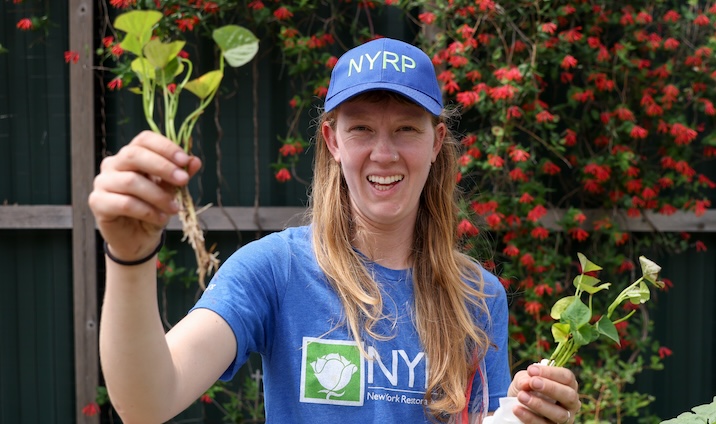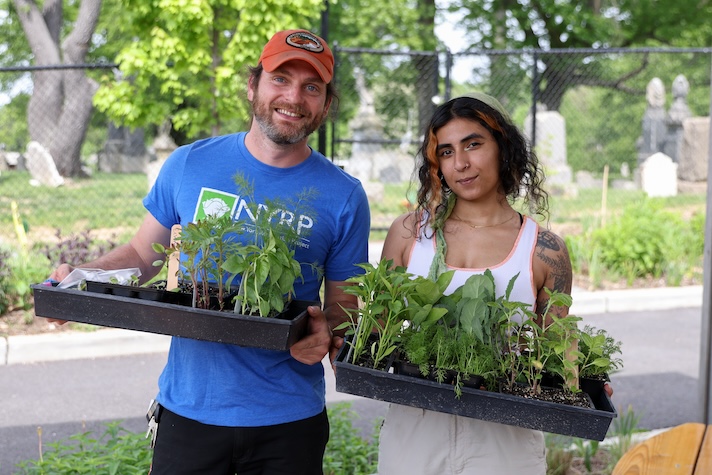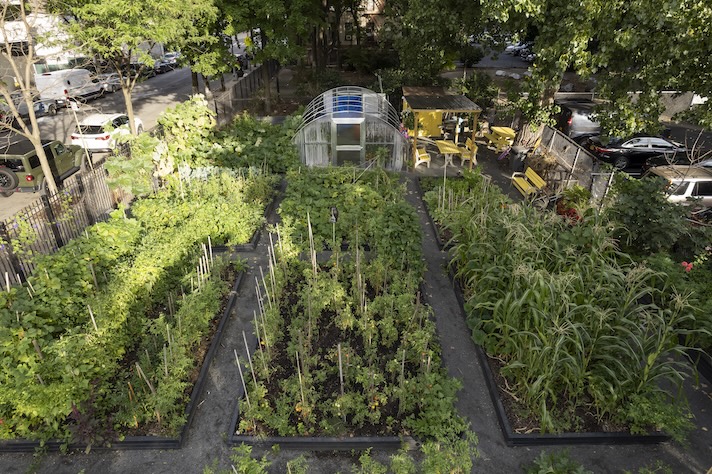Urban Agriculture | January 24, 2024
Urban Agriculture Support for Over 1,000 New Yorkers
 NYRP's Urban Agriculture Manager Genevieve Harding helps distribute plants to gardeners. Photo credit: Ann-Sophie Fjellø-Jensen
NYRP's Urban Agriculture Manager Genevieve Harding helps distribute plants to gardeners. Photo credit: Ann-Sophie Fjellø-Jensen Imagine you’re a first-time gardener in New York City. You may have a raised bed and dreams of fresh produce, but you may also have no clue where to begin. There are books and the internet, of course, but wouldn’t it be more helpful to connect with an expert and larger gardener community who could visit your garden and advise you on exactly how to proceed? Wouldn’t it be ideal if they could tell you where to get your seedlings, when to plant them, and how to best care for them all season long?
This is one example of the kind of support New York Restoration Project’s Urban Agriculture (UA) program provides to over 1,000 gardeners with different levels of experience across New York City. Founded in response to the pandemic in 2021, NYRP’s UA program has since doubled its capacity to offer over 165 workshops, skill shares, and technical consultations in 2023 alone. The team’s two full-time and two seasonal staff serve NYRP’s 52 portfolio gardens citywide and our Gardens for the City partners.
We sat down with NYRP’s Director of Urban Agriculture Corey Blant and Urban Agriculture Manager Genevieve Harding to learn more about their observations and experiences across the city’s gardener network, as well as their plans to serve this community in 2024.

NYRP Director of Urban Agriculture Corey Blant (left) assists a gardener at the spring plant giveaway. Photo credit: Ann-Sophie Fjellø-Jensen
You’ve essentially built NYRP’s urban agriculture program from the ground up, Corey. How does having more dedicated urban agriculture staff help NYRP better serve our gardener network? What can the program do with more people?
Corey Blant: NYRP’s urban agriculture program has exactly doubled its capacity since it began in 2021. We started as two people, now we’re four; we had one vehicle, now we have two. That’s twice the power!
More specifically, though, having greater bandwidth means that we’re able to better steward and build our relationships with gardeners over time. We can be more helpful to more people for longer. We can build tomato trellises and train a group to use them one summer, and then return to the same space the following year and install irrigation. The gardens where we have these long-term relationships are on a great trajectory to succeed over time.
We’re now also able to maintain a best-practices garden in Inwood at Riley-Levin Children’s Garden in Sherman Creek Park. It’s a place that we can consistently control a bit more and demonstrate different garden techniques like bed preparation, trellis-building, pest management, and so on. We can also use it to learn how to best grow new and different things that our gardeners may want, like mushrooms in the garden’s edible forest garden section. It’s a huge deal for us to have this central area where we can both gather our gardener network and eventually invite in expert partners with specific specialties. It is our outdoor classroom!
View this post on Instagram
Beyond our day-to-day work in the field, I’m especially proud of our growing library of multilingual written materials like fliers, posters, and other hard copies that the urban ag team has made and distributed over time. These are on everything from spider mite mitigation to planting cover crops. We have seen gardeners use these to teach others, whether they are fellow gardeners or visiting students. I’ve even seen these materials outside of the gardens where we work! They now have their own life and are rippling throughout the city.
What are some of the consistent needs that gardeners have every year? How have you addressed them?
CB: Across the board, I would say that folks need their garden beds to be full and thriving. That’s the need. The foundation of any garden is happy and healthy plants that are meaningful to the gardeners.
One of the main ways we help meet this need is supplying top-quality spring plants for our gardeners. We also show them how to make that planting successful: you need to weed this, you need to water this, you need to keep this covered with insect netting so that the cabbage white butterflies don’t come in and eat all your brassicas, and so forth.
We also want to help people to understand that spring is not the only time of year to plant. There are opportunities to keep planting and harvesting throughout the growing season. One of our gardeners just harvested beautiful broccoli in Brownsville in Brooklyn at the beginning of January!
View this post on Instagram
Genevieve Harding: I would also add that gardeners are eager to receive any kind of support. This is often either material supplies like watering cans and trellis infrastructure, or educational resources like NYRP materials and in-person skill shares. This demand is especially great in brand-new gardens, like a school, for example, where the group’s own resources might be limited. It means a lot that we provide high-quality plants across all our groups since not all gardens have equal access to the varieties they would like.
Beyond the basics, what are some of the special interests that gardeners have? What is capturing growers’ imaginations?
GH: Gardeners are thinking creatively about what they can do with their harvest. I have noticed a lot of people wanting to grow crops that support activities or needs in their community. Some examples might be growing food to donate to local food pantries, community fridges, and community kitchens; or growing herbs and medicinal plants for drying and making teas. Several of our gardens grow plants for natural dying, or specifically for seed-saving.
CB: I agree with that. We’ve also had a lot of interest in high tunnels to help extend the growing season and we built two of them this past year. Our community remains also really excited about growing mushrooms, which we are now cultivating on logs and in buckets. There’s also a lot of excitement for turmeric and ginger, which are important crops for many of our gardeners.

NYRP’s Clinton Avenue Community Garden in the East Tremont section of The Bronx received a new high tunnel this past season. Photo credit: Ben Hider
Were there any new needs that arose this past year? If so, how did you meet them?
GH: I think the demand for high tunnels or green houses also applies here: more spaces are interested in infrastructure to help extend their growing season and/or start seedlings on their own.
There was also a demand for water access and irrigation infrastructure throughout our network. Many gardens in New York City do not have a water hook-up within their space and must rely on a nearby hydrant. This can be daunting since hydrant access requires a permit, not to mention that they are also challenging to open. This is especially true in the hot summer months!
CB: Yes, there is a huge demand for irrigation support. There was a wildly positive response to every irrigation project we did, from a sprawling school farm in the South Bronx to a rooftop on the Lower East Side.
We helped install irrigation systems across six different spaces in 2023. Each system was designed with each group and highly customized to meet the unique needs of their space. We generally promote drip irrigation systems that have WiFi-enabled timers that can be activated from a phone app. This is a huge deal because someone doesn’t always have to physically be in the space to water—it can be done remotely. We want these systems to work for both people and plants!
Thinking of irrigation, how is our changing climate impacting gardeners’ experiences?
CB: In addition to irrigation, we’re seeing that people are growing more and different crops for longer periods. This is an unexpected and not entirely negative change. We’re even considering planting a banana tree in Sherman Creek Park this coming year!
GH: I would add that our milder winters, warm springs, and changing frost dates have led to different pest pressures and increased pest unpredictability in gardens. Every year is a little different: in 2022 spider mites were a huge problem, and in 2023 they weren’t. In general, pest issues are just more difficult to anticipate.
Tell us about 2024 programming. What are you looking forward to this season?
GH: We will definitely provide more irrigation support—water must be more accessible for our gardeners! We will also continue mushroom education while demystifying the many different methods and settings for growing them including in smaller areas, shaded spaces, forested and perennial areas, and so forth. I’m also looking forward to working with gardeners to source and grow plants that are most interesting and relevant to them like hibiscus, pigeon peas, ají dulce, and papalo to name a few.
CB: A totally new urban agriculture initiative this year is our Winter Academy. One major component of it will be a three-day training specifically for our 2024 Gardens for the City partners that covers a range of topics including a general intro to growing food in New York City, a deep dive into garden planning, and a description of the kind of support they can expect from NYRP. The hope is to help our partners better plan for how they want to use their garden before the growing season begins.
The other major Winter Academy curriculum will include several growing intensives like ginger cultivation, mushroom log inoculation, and plant propagation. Again, these are primarily for 2024 GFTC partners, but there may be space for other growers in our network.
Another big thing on my mind this year is helping figure out how NYRP can help fill in the community composting gap since the City has cut funding for so many of our composting partners late in 2023. We want to observe in the coming months to best decide how we can help groups adapt. We can’t fill the void that’s been left, but we want to help our gardens find a way forward nonetheless. Stay tuned!
New York Restoration Project’s Urban Agriculture program is grateful to receive generous support from: USDA Natural Resources Conservation Service; USDA Office of Urban Agriculture and Innovative Production; Bloomberg Philanthropies; The Burpee Foundation; The City Gardens Club of New York City; Con Edison Power of Giving; Farm Credit Northeast AgEnhancement; Medical Center Neighborhood Fund of Columbia University Medical Center; The New York Community Trust; and New York City Council Members Carmen De La Rosa, Amanda Farias, Chi Osse, Althea Stevens, Oswald Feliz, Kevin Riley, Sandy Nurse, Nantasha Williams, Kamillah Hanks, Pierina Ana Sanchez, and Shaun Abreu.